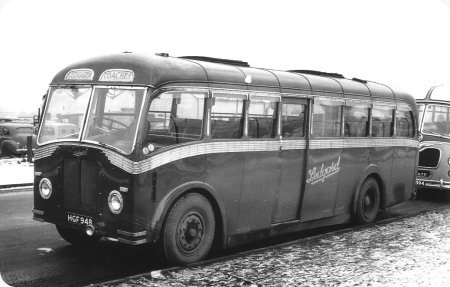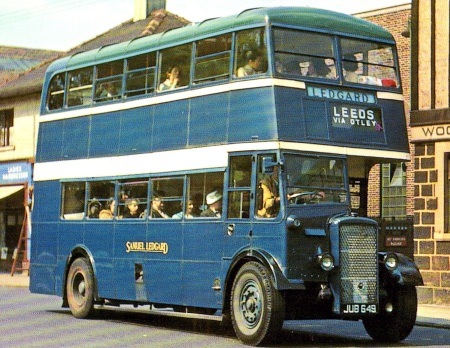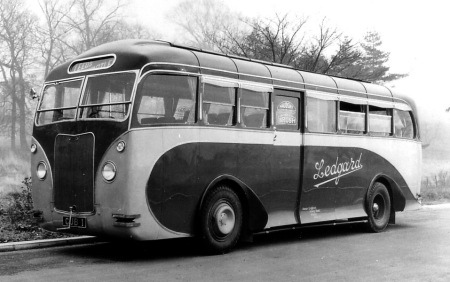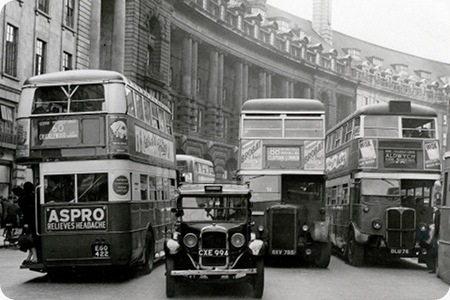Widnes Corporation – Daimler CWA6 – FTF 207 – 59
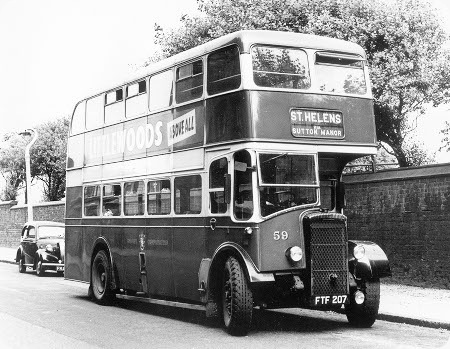
Photograph by ‘unknown’ if you took this photo please go to the copyright page.
Widnes Corporation
1945
Daimler CWA6
Duple UL55R – East Lancs L27/28R 1955
This photo was sent to me by Richard Mercer after he had seen the posting of the London Transport Daimler D1 which also had a Duple body, but as Richard points out this one is more rounded with softer edges and not so angular as the LT one. As there is only one year between this vehicle and the LT one it leads to the question was this bus rebodied before this shot was taken, and if it was, is it possible that it was done by East Lancs. What I like about it is the very shapely cab door, side window and windscreen the driver had good visibility from that cab. Richard has fond memories of this bus which was photographed in St Pauls Road Widnes as it was his school bus in the 1950,s. The bus was withdrawn in 1967 and went to a dealer in Wombwell South Yorkshire I do not know if it had a life after that, if you know, let me know.
Photograph and information contributed by Richard Mercer
A full list of Daimler codes can be seen here.
12/06/11 – 10:41
The asymmetrical upper deck window arrangement was not as may be thought a simple repair job but the standard adopted by Widnes for all its new double deck deliveries until the switch to saloons in the nineteen sixties.
Chris Hough
12/06/11 – 11:27
This looks like an East Lancs body to me, and this is borne out by another picture of this bus on the Omnicolour Bussslides website. East Lancs apparently managed to convince the authorities that it could not adopt the severe austerity style of construction specified for the standard Utility bodywork without disrupting production, and its wartime bodies were built to the usual East Lancs appearance, though one imagines that the general embargo on the use of lightweight alloys and other materials must have applied. It is possible, therefore, that the body shown is original. However, the neat, well proportioned lines of the body on this Widnes bus certainly looks like an East Lancs product of the 1950s to me.
Roger Cox
13/06/11 – 07:46
I am no expert on these matters but it definitely looks like a rebody to me. The radius corner flush mounted side windows and sliding ventilators don’t look like those from a utility body and the front and rear domes are too rounded. It does have an East Lancs look about it though.
Ian Wild
13/06/11 – 07:48
FTF 207 was indeed rebodied by E/Lancs with this lowbridge body in 1955. Several Daimlers from the same batch and and also the 1943 batch received E/Lancs highbridge bodies around the same period.
My information is taken from the 1965 edition of Ian Allan British Bus Fleets book 6, Lancashire Municipal fleets.
Eric
13/06/11 – 07:51
Yes indeed. BBF6 has this as rebodied by East Lancs in 1955. However, it is shown as L55R rather than H55R, with FTF 208 rebodied at the same time as H60R.
Peter Williamson
13/06/11 – 10:41
As a stranger to the area and the operator I can’t possibly comment on the accuracy of the fleet lists, but unless its an optical illusion it certainly looks like a highbridge body. It is an extremely handsome vehicle – however tall it is !!
Chris Youhill
13/06/11 – 10:32
If you look at the handrail running alongside the upperdeck off side windows this confirms that it is a sunken gangway lowbridge body and the roofline is much flatter than the highbridge version.
My home town of Huddersfield had two batches of Regent III’s in 1954/5 with identical lowbridge bodies to this one. They also had a batch of highbridges in 1955 with a much more rounded roof profile. Leigh Corporation also had a batch of lowbridge Regent III’s around the same time and there is a photo of one of these in the 1965 BBF6
Eric
There is a shot of a Leigh Regent here and a Huddersfield one here.
Peter
13/06/11 – 12:11
I’ve just had a look at the photo of the Leigh one and whilst it is of the same general style as the Widnes/Huddersfield bodies I have noticed that the windows are not as flush as in the newer bodies and the radius corners of the pillars are slightly more angular. So the Leigh bodies are to the earlier design of about 1951. Again, Huddersfield had a batch each of highbridge and lowbridge bodies to this design delivered in 1951/2 the highbridges being 170-5 (FVH 170-5) of 1951 and the lowbridges 226-31 (GCX 26-31) of 1952. The also had a batch of highbridges delivered in 1950, 163-9 (EVH 563-9) but these bodies were of a totally different style altogether. So perhaps this shows that East Lancs were "on the ball" when it came to body design and updating.
Eric
14/06/11 – 08:23
Another good way of telling that it’s lowbridge is the gutter moulding above the lower saloon. This dips down behind the cab and then up again at the rear bulkhead and is in line with the floor. The drainage from the upper saloon floor would be behind that moulding.
David Beilby
15/06/11 – 07:09
I found this very confusing at first. I’ve never seen a picture of this before and I was initially unable to decide between Duple or East Lancs but it clearly is the latter as has now been proven. I think the confusion can be explained through the links posted by Peter W, this vehicle is obviously 7ft 6in wide, which gives the impression of extra height although it is lowbridge and dissembles the East Lancs look to a degree. The Leigh and Huddersfield vehicles are clearly 8ft wide and look more as you expect East Lancs to look for the period.
How nice to read that it achieved 22 years service!
Chris Barker
15/06/2011 15:55
Perhaps the missing push out ventilator on the off side upperdeck front window makes some people question if it is an East Lancs body and I think it does detracts slightly from what is an otherwise classic design of the period.
Eric
16/06/11 – 09:20
East Lancs bodied the majority of Widnes fleet in post war years a batch of East Lancs bodied PD2s which were to prove Widnes last deckers all had the winking eye upper deck treatment East Lancs even bodied a rather bizarre coach for Widnes in the sixties They switched to Nationals and later the Lynx when these became available
Chris Hough
Just dug out my very well thumbed BBF No 6 Lancashire – dated 1960 (Price 3/6d) and 59 was definitely East Lancs L57R rebodied in 1955 on the original CWA6 utility chassis. Some of this batch were CWD6 and some retained their utility bodies and were never rebodied at all. I remember seeing a utility bodied example in St Helens in the early 1960’s probably 1961/2 from memory.
For the record if anybody is interested according to this issue of BBF6 (and they were normally pretty accurate in those days) the details of the batch still in stock at 1960 are:-
49/51/53/60 – East Lancs H60R rebodied 1955
54 Northern Counties UH56R
55/56/57 Duple UH56R
58 Duple UL55R
59 East Lancs L57R rebodied 1955
So 59 was the only lowbridge East Lancs rebody.
I have them all underlined as being ‘copped’ apart from 54 which I have crossed out so it must have been an early withdrawal.
I agree that the single front ventilator which was a Widnes trait made the buses look a bit ‘botched’ and detracted from what otherwise was a tidy fleet. I presume the logic was that passengers wanting the fresh air treatment could choose to sit on the nearside while those of a less robust disposition could take to offside!
I remember a spotting trip to Widnes in 1962 when I copped these buses and at that time the new Widnes-Runcorn bridge had not long been open. We took a walk over it and the old Transporter Bridge was in the process of being dismantled. I regret that I never saw it in operation.
It was only after the opening of the new bridge that Widnes buses ventured over to Runcorn and previously terminated on the Lancashire side of the river to allow passengers for Runcorn to alight and go as foot passengers on the Transporter.
The bus drop-off point and the old Transporter Power Building is still in place at the end of a side street of terraced houses. The rest was all demolished.
Philip Halstead
21/08/15 – 06:02
58 and 59 were the only two in the fleet with the side gangway upstairs (handrail visible on 59), the seats being four in line on the nearside. 58 was a more decrepit unit so was probably in original form? My grandmother would never travel on upper decks as smoking was allowed, hence the ventilators. Downstairs she would try to avoid the offside seats on these two as headroom was restricted because of the sunken gangway upstairs. I witnessed many a cracked skull.
Kenneth Aaron
06/09/17 – 06:28
3 that I know of, 49, 51 and 60, had Leyland bodies in the mid 1950’s
Richard Mercer
16/05/20 – 06:32
I was interested to read the comment by Chris Hough (12/6/11) concerning the asymmetric upper deck window arrangement on Widnes buses.
My father J H (Harry) Craggs was general manager of Widnes Corporation for many years (from around 1950-1965) and I recall very clearly, when I was a young boy, he mentioned the reason for this unusual configuration! He told me that one window was sufficient to get good upper deck ventilation… two were not necessary and having both opened at the same time could cause drafts. It seemed both logical and fascinating at the time and I never forget this unusual conversation, even all these years later!
John Craggs
Quick links to the - Comments Page - Contact Page - Home Page
